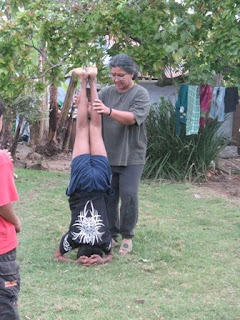Seeing Kodai with Nath Uncle (Nanaji as the children fondly called him) was perfect! Nath Uncle did a lot of wonderful activities with us.... showed and shared with us his carpentry tools and passion.... taught us how to make maida glue.....reuse envelopes.... make sturdy boxes....recited urdu poetry for us... made meal time a jolly time ... often broke into a song (which the children enjoyed!)...took us boating..It turned out that he had planned many more things to do with us, but the six days was not enough :) We also walked a lot in and around Kodai with him... he's been there for more than 25 years now and knows almost every other person who crossed our paths....
We also met a lot of other wonderful people....friends of Nanaji......Harry Uncle who owns a restaurant called Tava treated all of us to a wonderful meal,where we ate as much paneer and srikhand as we could! :) ... Prasanna Uncle and Meenakshi aunty who run a little bakery called Daily Bread.....invited us for breakfast and stuffed us with cream rolls,sandwiches,pastry,pizza and hot chocolate...they also gave a tour of there small bakery where all the goodies were made !! We also visited a school run by Padmini Aunty and participated in the art class there and all the children played football together... Subramaniyam Uncle did pottery with us ....
On our walks, the the clouds opened up to magnificent views, we saw flowers in so many colours ,we walked through many farms and we ate radish flowers while we went through them. On these walks in and around Kodai Nanaji would talk about terrace farming and explain what a valley is ! :)
We also met a lot of other wonderful people....friends of Nanaji......Harry Uncle who owns a restaurant called Tava treated all of us to a wonderful meal,where we ate as much paneer and srikhand as we could! :) ... Prasanna Uncle and Meenakshi aunty who run a little bakery called Daily Bread.....invited us for breakfast and stuffed us with cream rolls,sandwiches,pastry,pizza and hot chocolate...they also gave a tour of there small bakery where all the goodies were made !! We also visited a school run by Padmini Aunty and participated in the art class there and all the children played football together... Subramaniyam Uncle did pottery with us ....
On our walks, the the clouds opened up to magnificent views, we saw flowers in so many colours ,we walked through many farms and we ate radish flowers while we went through them. On these walks in and around Kodai Nanaji would talk about terrace farming and explain what a valley is ! :)
Apart from all these activities...the children did stitching with Roopa aunty....played mikado, carom, trees, collected wood, plucked brambles,sang songs, saw snakes and listened to stories before we went to bed!
We stayed with N in his beautiful house on the side of a hill.It is in the middle of a farm with pear and plum and peach trees. The plums were just ripening as we walked through.....In N's house Elsy akka cooked simple but yummy food for us and John anna took us around the garden and plucked fruits with us.
We also have to introduce another friend we made during our stay at Kodai.... Whitey.... the
We stayed with N in his beautiful house on the side of a hill.It is in the middle of a farm with pear and plum and peach trees. The plums were just ripening as we walked through.....In N's house Elsy akka cooked simple but yummy food for us and John anna took us around the garden and plucked fruits with us.
We also have to introduce another friend we made during our stay at Kodai.... Whitey.... the
pampered and hugely loved dog! :)
Roopa's sharing
It felt great to be able to share home and birth family with the Shibumi family, and the responses of the children were a delight to watch. When my father first saw them , he wondered aloud" They look very young, will they be able to stay away from home for so long?"
On the last day, the children were sorry the excursion was over so quickly.
Some of the learning was for us, seeing them in new situations.....when to intervene, when to just watch , and often Tanu and myself would exchange notes on our responses to a situation.
For the children I think it was a long time away from the familiarity of family and home....and it was amazing how easily they adjusted. On our return , as we sat on the Kodai road railway station eating our curd rice off banana leaves, co passengers curiously asked about our 'family'!
And personally, for me it was wonderful to have the house filled with laughter and noise.....my mother who was one of the most amazing teachers I knew was surely part of the celebration from wherever she has gone to!

















































Hi Guys,
ReplyDeleteNice guys,it makes me to go to my childhood